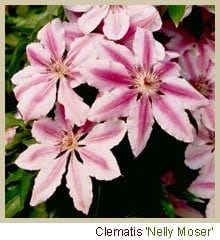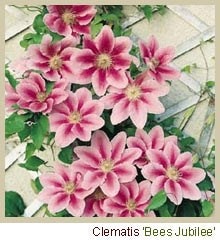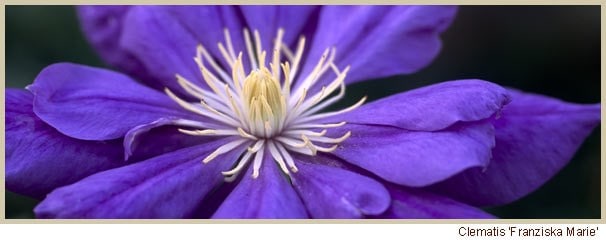Large Flowered Clematis
It is difficult not to get excited about this fabulous group of plants. Their big, bold, brightly coloured flowers, coupled with their versatile growth habits, make this one of the most popular plant groups of all time. There is no secret to their success. They are generally hardy and produce flowers in a wide range of colours, which can measure up to 25cm in diameter. Several varieties will flourish in containers, making them suitable for even the smallest town garden where space is always at a premium. In the wild, you will find them scrambling through other plants for support, and this natural style works just as well in the garden. They will be equally happy simply covering a wall supported by trellis, scrambling over obelisks in the border, or adding colour to pergolas, archways and gateways.
Social climbers

With a bit of thought these plants can produce remarkable displays when coupled with other plants. Combining two clematis that have contrasting coloured flowers, such as ‘Niobe’ and ‘Gillian Blades’ can be really very dramatic, while a quieter look can be achieved with some of the softer shades like those of ‘Proteus’ and ‘Nelly Moser’. It needn't stop there though since there is a whole host of plants that make superb partners. The early varieties will flower at the same time as wisteria and would look wonderful smothered in the double white flowers of ‘Arctic Queen’, while the mid or late varieties could be teamed up with some of your favourite roses.
Sometimes you can simply use the foliage colour of a neighbouring shrub as the perfect foil. Purple- and silver-leaved plants will contrast well with the deep pink flowers of ‘Asao’, while some of the darker purple shades, (‘Rouge Cardinal’, ‘Jackmanii’, or ‘Warsaw Nike’) will be show to best effect on golden foliage like that of Choisya ternata ‘Sundance’ or Sambucus racemosa ‘Sutherland Gold’. Of course, if you plant a late-flowering clematis such as ‘Comtesse de Bouchard’ with a shrub that flowers earlier in the year, such as Ceanothus ‘Concha’, you will seemingly double the flowering period.
Early large-flowered varieties

This group has been largely derived from Clematis patens - a native from China and Korea. They are generally compact, growing to about 2-3m, so ideal for covering a single fence panel. Flowers are produced in late spring, or early summer, and many will produce a second flush of flowers during late summer or early autumn – some even flower continuously before producing attractive seedheads. They are ideal for growing through other wall-trained plants, and because of their compact, free-flowering habit they are also ideal for growing in containers. They belong to pruning group 2. Good varieties to look out for include ‘Asao’ (large, deep pink flowers with contrasting yellow centres), ‘Barbara Jackman’ (wonderful mauve-blue, flowers with a distinctive carmine stripe), ‘Bees Jubilee’ (eye-catching deep pink, with a darker pink stripe) and ‘Doctor Ruppel’ (splendid rose-pink, with deep reddish-pink stripes).
Crocus tip
Planting climbers together. Choose a clematis to suit the situation and complement the existing climber. Excavate a hole about 60cm away from the base of the plant and at least 30cm away from the wall support. Line the sides of the hole with old timber to prevent surrounding roots spreading and so give the new climber time to establish without competition from the established climber's roots. The wood will eventually rot away. Plant as normal, angling the cane support of the new climber towards the existing one and tie in. Water and mulch after planting and keep well watered until established.
Mid–season varieties
Generally derived from Clematis lanuginose, again a native from China. The first flush of flowers can be enormous, reaching up to 25cm across, and when they have faded they will produce attractive seedheads. Some, such as 'Marie Boisselot', will continue growing and flowering as late as early winter in mild weather. You can grow them with other wall-trained plants as well as on archways and pergolas where they can grow up and over the structure before falling back down the other side. However, they are best when grown through other large free-standing shrubs or small trees such as magnolia and rhododendrons.
Some of the more compact types, such as 'General Sikorski' can be used in containers if you need later flowers than early or double/semi-double varieties. If you want the large early flowers then treat them as pruning group 2, leaving in some old ripened stems from the previous season, but if late flowers are required then prune according to group 3.
Late-flowering varieties
Most of this group have been developed from crosses between Clematis viticella and Clematis lanuginose. Single flowers are produced from mid-summer to autumn depending on locality and climate. They are ideal for growing with climbing, rambling or old roses giving additional colour when the rose has finished flowering or, with careful selection, while it is still in bloom. Late-flowering varieties can also be used to scramble along the ground through herbaceous perennials or bedding plants. A few, such as 'Rouge Cardinal' are suitable for containers. They belong to pruning group 3.
Crocus tip
Growing in containers. Clematis are ideal climbers for growing in containers where their colourful blooms can be enjoyed on the patio. Choose a large container, preferably wood or terracotta which are better insulated, and use a loam-based, John Innes No.3 compost. After planting cover the surface of the compost with a loose mulch, such as gravel, to help conserve moisture and keep the compost cool.
Double and semi-double varieties

Mostly these are derived from the old Japanese cultivars introduced in the 19th century or are sports (mutations) from single types. The main crop of flowers is produced in very late spring or early summer. Some will produce single flowers on current season's stems later in the summer or in the autumn, while others may produce both single and double flowers at the same time. They will all follow on with attractive seedheads after the flowers have faded.
Double and semi-double varieties look great growing through other wall-trained shrubs which not only provide the support but also offer much-needed protection from wind and rain. You can use them as container plants for the patio, too, where they will put on a spectacular display. They are best planted in positions facing south-west or east, since if it is too shady the first crop of flowers may open slightly green or misshapen due to poor light. They belong to pruning group 2.
Growing guide
The large flowered clematis will thrive in a deep, loamy soil in sun or part shade, but it is important to provide them with a cool root run so they must have shade at their base. If you have a very open position then it is a good idea to plant another low-growing, shallow-rooted plant, such as the hebes 'Red Edge' or H. topiaria, at its base, which will help protect the roots from sun. Stone slabs can also be used, or you can give your clematis the best of both worlds by placing a specially designed terracotta tile around the plant to keep their roots cool in the summer while providing much-needed protection in winter.
Before planting a clematis, prepare the site as well as possible by adding lots of well-rotted compost or manure to the surrounding soil. Clematis love being planted deeply, so sink them about 6cm below the level of the soil in their old container. This not only provides them with cooler roots, but it also allows for buds to develop below the soil level, which will help a plant recover if it succumbs to the dreaded clematis wilt disease. If you are potting them up into a large pot, then choose one that has nice thick sides – terracotta or reconstituted stone are ideal. Provide strong support for them to climb on and tie them in as they grow. Mulch in late spring with well-rotted compost or manure.
Crocus tip
More flowers. Clematis can be very floriferous climbers which makes them very thirsty and hungry plants. To get the best displays you will have to make sure they do not run short of water – which may mean a can full each evening in summer during hot spells. Once established, feed monthly during the growing season with a good general-purpose fertiliser such as Miracle Gro.
Pruning made easy
Most people get a bit confused when it comes to pruning clematis, but as long as you know which group your plant belongs to, it is really very simple. All large-flowered types fall into two categories, early summer flowering varieties (pruning groups 2) and mid-summer flowering varieties (pruning group 3).
Propagation
Cuttings (known as double-leaf bud cuttings) or layering are the two methods of propagation suitable for the named varieties, because seed will never come true to type.
Cuttings. Choose vigorous, healthy material that is not flowering. Remove a section of stem from the main plant about 4–5cm below a leaf joint using a sharp knife. Make a second cut a 5mm above the leaf joint. Trim off the leaves on one side of the stem to help reduce water loss, and remove one leaflet and its stalk from the other side leaving at least two leaflets in place. Dip the base of the cutting in hormone rooting powder and plant up into a small pot filled with gritty compost. When the roots have developed, pot up into a bigger container using a general-purpose compost and keep in a sheltered place. Rooted cuttings should be kept in a pot for at least one year before planting out into the garden in spring.
Layering. Select a healthy, vigorous low-growing shoot. Use a sharp knife to nick the part of the stem that can be bent down to ground level. Brush the wound with hormone rooting powder and gently shake off excess. Then scoop out a hole 8cm deep and bury the nicked portion of the stem in the soil so that the growing tip is above ground. Cover with potting compost, and leave it still attached for up to two years. During this time a good root system should develop where the stem has been nicked and it can then be severed from the parent plant and planted out in spring or autumn.
Clematis wilt disease
This serious disease can kill off all the parts of the plant above ground, but if you plant them deeply, then they should re-grow. If the disease does strike, prune out all affected stems, cutting them right back to healthy wood, which may mean cutting back to ground level if necessary.







